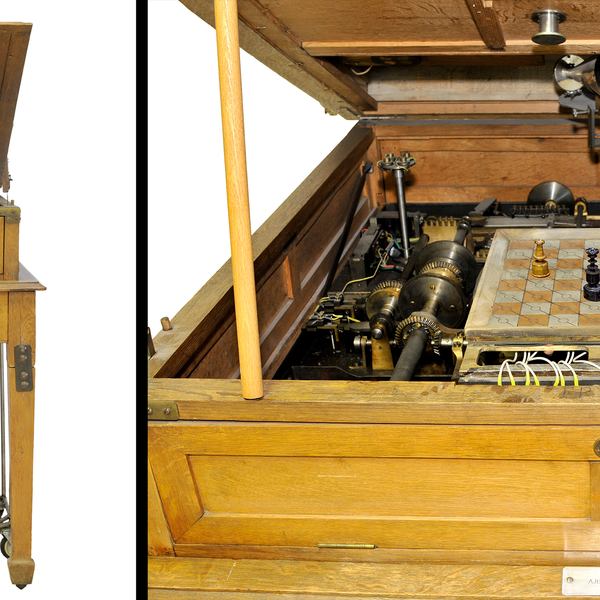This 1920 Chess Automaton Was Wired to Win

The Mechanical Turk was a fraud. The chess-playing automaton, dressed in a turban and elaborate Ottoman robes, toured Europe in the closing decades of the 18th century accompanied by its inventor Wolfgang von Kempelen. The Turk wowed Austrian empress Maria Theresa, French emperor Napoleon Bonaparte, and Prussian king Frederick the Great as it defeated some of the great chess players of its day. In reality, though, the automaton was controlled by a human concealed within its cabinetry.
What was the first chess-playing automaton? Torres Quevedo made his mark in a number of fields, including funiculars, dirigibles, and remote controls, before turning to thinking" machines.Alamy
Torres Quevedo made his mark in a number of fields, including funiculars, dirigibles, and remote controls, before turning to thinking" machines.Alamy
A century and a half after von Kempelen's charade, Spanish engineer Leonardo Torres Quevedo debuted El Ajedrecista (The Chessplayer), a true chess-playing automaton. The machine played a modified endgame against a human opponent. It featured a vertical chessboard with pegs for the chess pieces; a mechanical arm moved the pegs.
Torres Quevedo invented his electromechanical device in 1912 and publicly debuted it at the University of Paris two years later. Although clunky in appearance, the experimental model still managed to create a stir worldwide, including a brief write-up in 1915 in Scientific American.
In El Ajedrecista's endgame, the machine (white) played a king and a rook against a human's lone king (black). The program required a fixed starting position for the machine's king and rook, but the opposing king could be placed on any square in the first six ranks (the horizontal rows, that is) that wouldn't put the king in danger. The program assumed that the two kings would be on opposite sides of the rank controlled by the rook. Torres Quevedo's algorithm allowed for 63 moves without capturing the king, well beyond the usual 50-move rule that results in a draw. With these restrictions in place, El Ajedrecista was guaranteed a win.
In 1920, Torres Quevedo upgraded the appearance and mechanics of his automaton [pictured at top], although not its programming. The new version moved its pieces by way of electromagnets concealed below an ordinary chessboard. A gramophone recording announced jaque al rey (Spanish for check") or mate (checkmate). If the human attempted an illegal move, a lightbulb gave a warning signal; after three illegal attempts, the game would shut down.
Building a machine that thinks The first version of the chess automaton, from 1912, featured a vertical chessboard and a mechanical arm to move the pieces.Leonardo Torres Quevedo Museum/Polytechnic University of Madrid
The first version of the chess automaton, from 1912, featured a vertical chessboard and a mechanical arm to move the pieces.Leonardo Torres Quevedo Museum/Polytechnic University of Madrid
Unlike Wolfgang von Kempelen, Torres Quevedo did not create his chess-playing automaton for the entertainment of the elite or to make money as a showman. The Spanish engineer was interested in building a machine that thinks"-or at least makes choices from a relatively complex set of relational possibilities. Torres Quevedo wanted to reframe what we mean by thinking. As the 1915 Scientific American article about the chess automaton notes, There is, of course, no claim that it will think or accomplish things where thought is necessary, but its inventor claims that the limits within which thought is really necessary need to be better defined, and that the automaton can do many things that are popularly classed with thought."
In 1914, Torres Quevedo laid out his ideas in the article, Ensayos sobre automatica. Si definicion. Extension teorica de sus aplicaciones" (Essays on Automatics. Its Definition. Theoretical Extent of Its Applications"). In the article, he updated Charles Babbage's ideas for the analytical engine with the currency of the day: electricity. He proposed machines doing arithmetic using switching circuits and relays, as well as automated machines equipped with sensors that would be able to adjust to their surroundings and carry out tasks. Automatons with feelings were the future, in Torres Quevedo's view.
How far could human collaboration with machines go? Torres Quevedo built his chess player to find out, as he explained in his 1917 book Mis inventos y otras paginas de vulgarizacion (My inventions and other popular writings). By entrusting machines with tasks previously reserved for human intelligence, he believed that he was freeing humans from a type of servitude or bondage. He was also redefining what was categorized as thought.
Claude Shannon, the information-theory pioneer, later picked up this theme in a 1950 article, A Chess-Playing Machine," in Scientific American on whether electronic computers could be said to think. From a behavioral perspective, Shannon argued, a chess-playing computer mimics the thinking process. On the other hand, the machine does only what it has been programmed to do, clearly not thinking outside its set parameters. Torres Quevedo hoped his chess player would shed some light on the matter, but I think he just opened a Pandora's box of questions.
Why isn't Leonardo Torres Quevedo known outside Spain?Despite Torres Quevedo's clear position in the early history of computing-picking up from Babbage and laying a foundation for artificial intelligence -his name has often been omitted from narratives of the development of the field (at least outside of Spain), much to the dismay of the historians and engineers familiar with his work.
That's not to say he wasn't known and respected in his own time. Torres Quevedo was elected a member of the Spanish Royal Academy of Sciences in 1901 and became an associate member of the French Academy of Sciences in 1927. He was also a member of the Spanish Society of Physics and Chemists and the Spanish Royal Academy of Language and an honorary member of the Geneva Society of Physics and Natural History. Plus El Ajedrecista has always had a fan base among chess enthusiasts. Even after Torres Quevedo's death in 1936, the machine continued to garner attention among the cybernetic set, such as when it defeated Norbert Wiener at an influential conference in Paris in 1951. (To be fair, it defeated everyone, and Wiener was known to be a terrible player.)
One reason Torres Quevedo's efforts in computing aren't more widely known might be because the experiments came later in his life, after a very successful career in other engineering fields. In a short biography for Proceedings of the IEEE, Antonio Perez Yuste and Magdalena Salazar Palma outlined three areas that Torres Quevedo contributed to before his work on the automatons.
 Torres Quevedo's design for the Whirlpool Aero Car, which offers a thrilling ride over Niagara River, debuted in 1916.Wolfgang Kaehler/LightRocket/Getty Images
Torres Quevedo's design for the Whirlpool Aero Car, which offers a thrilling ride over Niagara River, debuted in 1916.Wolfgang Kaehler/LightRocket/Getty Images
First came his work, beginning in the 1880s, on funiculars, the most famous of which is the Whirlpool Aero Car. The cable car is suspended over a dramatic gorge on the Niagara River on six interlocking steel cables, connecting two points along the shore half a kilometer apart. It is still in operation today.
His second area of expertise was aeronautics, in which he held patents on a semirigid frame system for dirigible balloons based on an internal frame of flexible cables.
And finally, he invented the Telekine, an early remote control device, which he developed as a way to safely test his airships without risking human life. He started by controlling a simple tricycle using a wireless telegraph transmitter. He then successfully used his Telekine to control boats in the Bilbao estuary. But he abandoned these efforts after the Spanish government denied his request for funding. The Telekine was marked with an IEEE Milestone in 2007.
If you'd like to explore Torres Quevedo's various inventions, including the second chess-playing automaton, consider visiting the Museo Torres Quevedo, located in the School of Civil Engineering at the Polytechnic University of Madrid. The museum has also developed online exhibits in both Spanish and English.
A more cynical view of why Torres Quevedo's computer prowess is not widely known may be because he saw no need to commercialize his chess player. Nick Montfort, a professor of digital media at MIT, argues in his book Twisty Little Passages (MIT Press, 2005) that El Ajedrecista was the first computer game, although he concedes that people might not recognize it as such because it predated general-purpose digital computing by decades. Of course, for Torres Quevedo, the chess player existed as a physical manifestation of his ideas and techniques. And no matter how visionary he may have been, he did not foresee the multibillion-dollar computer gaming industry.
The upshot is that, for decades, the English-speaking world mostly overlooked Torres Quevedo, and his work had little direct effect on the development of the modern computer. We are left to imagine an alternate history of how things might have unfolded if his work had been considered more central. Fortunately, a number of scholars are working to tell a more international, and more complete, history of computing. Leonardo Torres Quevedo's is a name worth inserting back into the historical narrative.
ReferencesI first learned about El Ajedrecista while reading the article Leonardo Torres Quevedo: Pioneer of Computing, Automatics, and Artificial Intelligence" by Francisco Gonzalez de Posada, Francisco A. Gonzalez Redondo, and Alfonso Hernando Gonzalez (IEEE Annals of the History of Computing, July-September 2021). In their introduction, the authors note the minimal English-language scholarship on Torres Quevedo, with the notable exception of Brian Randell's article From Analytical Engine to Electronic Digital Computer: The Contributions of Ludgate, Torres, and Bush" (IEEE Annals of the History of Computing, October-December 1982).
Although I read Randell's article after I had drafted my own, I began my research on the chess-playing automaton with the Museo Torres Quevedo's excellent online exhibit. I then consulted contemporary accounts of the device, such as Electric Automaton" (Scientific American, 16 May 1914) and Torres and His Remarkable Automatic Devices" (Scientific American Supplement No. 2079, 6 November 1915).
My reading comprehension of Spanish is not what it should be for true academic scholarship in the field, but I tracked down several of Torres Quevedo's original books and articles and muddled through translating specific passages to confirm claims by other secondary sources. There is clearly an opportunity for someone with better language skills than I to do justice to this pioneer in computer history.
Part of a continuing series looking at historical artifacts that embrace the boundless potential of technology.
An abridged version of this article appears in the July 2023 print issue as Computer Chess, Circa 1920."